Penobscot River Watershed Habitat Blueprint
Maine Sea Grant is working with The Nature Conservancy and NOAA on the Penobscot River Watershed “Habitat Blueprint” or Habitat Focus Area. The goal of the Habitat Blueprint is to continue to restore habitat for sea-run fish and other wildlife by removing barriers, building fishways and replacing culverts in the Penobscot River watershed.
The Habitat Blueprint builds on the landmark efforts of the Penobscot River Restoration Trust, the nonprofit organization established to implement the Penobscot River Restoration Project. The Penobscot Restoration has opened the mainstem of the River by removing the Great Works and Veazie dams and is building a bypass at the Howland dam while maintaining energy production. This effort greatly improves access to nearly 1,000 miles of habitat. (Read the 2016 Annual Report for updates on the overall project.)
By designating the Penobscot a Habitat Focus Area, NOAA seeks to further the benefits of the Penobscot River Restoration by ensuring that the many of the tributaries and ponds in the watershed are accessible for the fish and other aquatic wildlife that need to reach these waters. These areas are fragmented by 1,854 undersized culverts and hundreds of dams and other barriers. Addressing this is crucial if Penobscot River and bay are to realize the full potential of a restored ecosystem, including reviving the region’s traditional fishing heritage and waterfront communities.
Outreach Publications
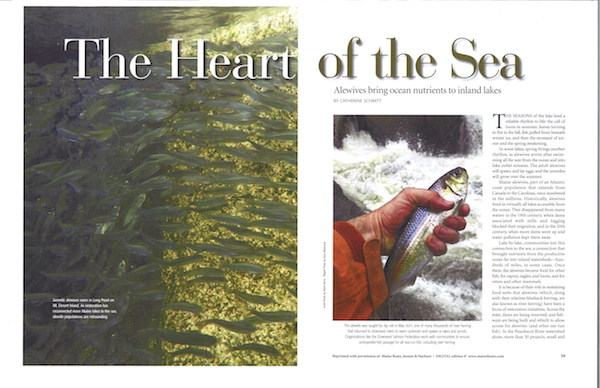 |
The Heart of the Sea: Alewives Bring Ocean Nutrients to Inland Lakes, an article in the May-June 2018 issue of Maine Boats, Homes & Harbors Magazine. The article provides an overview of sea-run alewives and their role in lake ecosystems, and interviews with researchers studying the impact of alewife restoration on Maine lakes. |
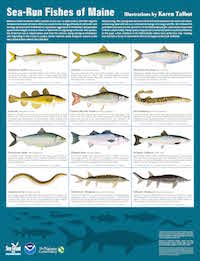 |
Sea-Run Fishes of Maine, a 24 x 30 poster featuring artwork by Karen Talbot. Email our office for copies.
|
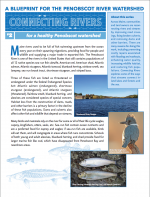 |
Connecting Rivers for a Healthy Penobscot Watershed. This second fact sheet in the series provides an overview of restoration activities in the Penobscot River watershed in the last 30 years, and describes the diverse motivations for restoring passage for sea-run fish and connecting habitat. |
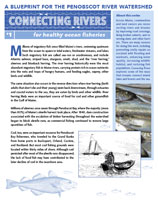 |
Connecting Rivers for Healthy Ocean Fisheries. This is the first in a series of fact sheets about the benefits of restoring stream connectivity, and focuses on the relationship between sea-run alewives and blueback herring and coastal populations of cod and other groundfish. |
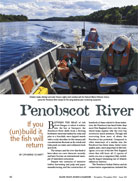 |
“Penobscot River Restoration,” in the Winter 2016 issue of Maine Boats, Homes & Harbors Magazine, describes the preliminary findings in the few years since dam removal, including an estuary filled with small, silvery fishes, and a series of surprises for scientists like University of Southern Maine’s Karen Wilson. |
Community-Specific Materials
Bagaduce River
In June 2018, the Town of Penobscot installed five new interpretive panels at Pierce’s Pond. A new nature-like fishway provides passage for alewives and other sea-run fish, along with viewing platforms and a picnic area at the public boat launch. The Town and alewife steward Bailey Bowden, along with local partners at Maine Coast Heritage Trust, Blue Hill Heritage Trust, and Maine Center for Coastal Fisheries, are leading the effort to restore migratory fish to the entire Bagaduce watershed. The Pierce’s Pond project was funded by NOAA Fisheries and The Nature Conservancy with Habitat Blueprint funding, with additional support from Maine Sea Grant and Maine Outdoor Heritage Fund.
Download the Bagaduce Fishway Panels PDF
Bagaduce River Watershed Map and Fisheries History
Orland (Naramissic) River
Orland River Watershed Map and Fisheries History
Orland River Watershed Map
Related Sea Grant Research and Outreach
Research: Variation in habitat use by juvenile river herring
Research: Restoration of anadromous fishes: the effects of dam removal and habitat conditioning
Extension: Marine ecology of Gulf of Maine Atlantic salmon
Extension: Rainbow smelt survey
Outreach: Penobscot Watershed Conference
Outreach: Penobscot River Watershed Kiosks
Outreach: Harvester perspectives on alewives, blueback herring, and American eelAdditional related publications:
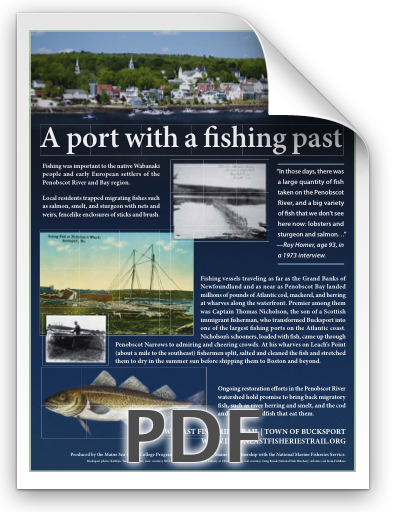 |
Fishing vessels traveling as far as the Grand Banks of Newfoundland and as near as Penobscot Bay landed millions of pounds of Atlantic cod, mackerel, and herring at wharves along the waterfront. Premier among them was Captain Thomas Nicholson, the son of a Scottish immigrant fisherman, who transformed Bucksport into one of the largest fishing ports on the Atlantic coast.
|
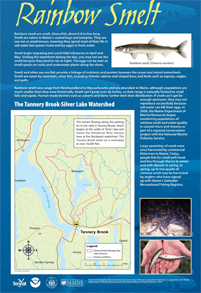 |
Rainbow Smelt: We produced this poster in partnership with NOAA National Marine Fisheries Service Orono Field Station and the Maine Department of Marine Resources. The poster was displayed in a kiosk on the Bucksport waterfront, and describes rainbow smelt monitoring activity in a stream adjacent to the kiosk (Tannery Brook, which flows into Penobscot Bay). |
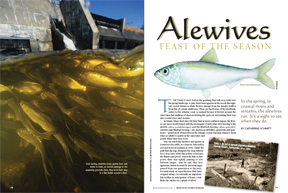 |
Alewives: Feast of the Season. Alewives are sea-run, or diadromous, fish that spend most of their lives in the Atlantic Ocean but return as adults to coastal rivers in spring to spawn in freshwater streams and ponds. This article in Maine Boats, Homes, & Harbors magazine discusses the natural and cultural history of Maine’s native runs of alewives and other sea-run fish. Watch a video of an alewife harvest. |
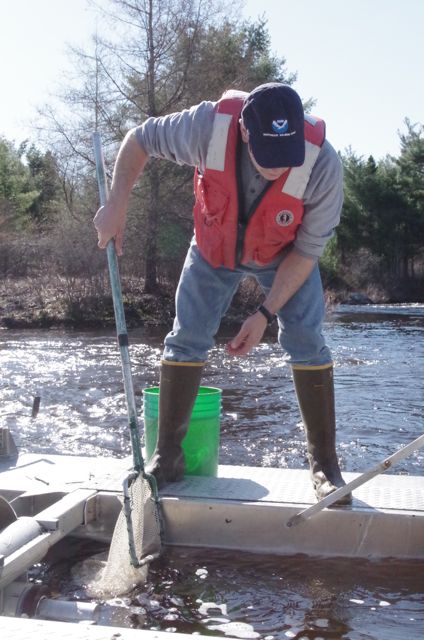 |
Counting smolts in May: a story of Atlantic salmon survival. A visit to the Piscataquis River, a major tributary of the Penobscot River, to monitor Atlantic salmon (Salmo salar) smolts with state and federal fish biologists. |
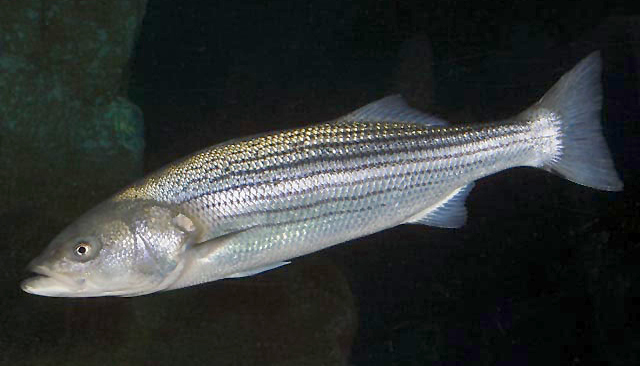 |
Study targets Striped Bass. This article in the Bangor Daily News profiles the Sea Grant-funded research of Dr. Joe Zydlewski, who is studying the striped bass population in the Penobscot River. A must read for all striper fans. |
